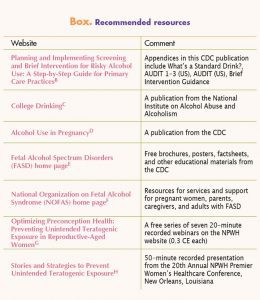By Beth Kelsey, EdD, APRN, WHNP-BC, FAANP and Marilyn Pierce-Bulger, MN, FNP-BC, CNM
How do nurse practitioners skillfully handle three challenging scenarios involving young women who are (1) at repeated risk for an unplanned pregnancy, (2) planning a pregnancy, or (3) currently pregnant—and who also drink alcoholic beverages?
JD, a 20-year-old female college student, presents at a student health center for emergency contraception. She reports that she had unprotected sex two nights previously. JD had discontinued her oral contraceptive (OC) 3 months previously because she believed that it was causing her to gain weight. She occasionally uses condoms. JD does not desire a pregnancy at this time. Upon further review of JD’s health history, the nurse practitioner (NP) learns that the patient drinks one or two beers on most weekends and that she has four or five beers at parties about once a month.
LS, a 29-year-old female, presents at the clinic, asking that her intrauterine contraceptive (IUC) be removed because she wants to become pregnant. As part of preconception counseling, the NP asks LS about alcohol use. LS becomes defensive, saying that she occasionally drank a glass of wine during her last pregnancy, that her healthcare provider (HCP) told her it was no big deal, and that her child is just fine.
In each of these two cases, the NP took the first step in implementing alcohol screening and brief intervention (SBI) by asking about alcohol use.
What is alcohol SBI?
 The National Association of Nurse Practitioners in Women’s Health, the American College of Obstetricians and Gynecologists, the CDC, and the U.S. Preventive Services Task Force all recommend that screening for at-risk alcohol use take place at least yearly for all adults in primary care settings.1-4 All pregnant women should be screened at the first prenatal visit and once during each trimester thereafter. When a patient screens positive for at-risk alcohol use, the NP should provide a brief intervention.
The National Association of Nurse Practitioners in Women’s Health, the American College of Obstetricians and Gynecologists, the CDC, and the U.S. Preventive Services Task Force all recommend that screening for at-risk alcohol use take place at least yearly for all adults in primary care settings.1-4 All pregnant women should be screened at the first prenatal visit and once during each trimester thereafter. When a patient screens positive for at-risk alcohol use, the NP should provide a brief intervention.
The main goal of alcohol SBI is to motivate patients to be aware of their alcohol consumption patterns, understand the associated risks of drinking and the options for reducing or eliminating these risks, and make their own decisions. Key steps in alcohol SBI include the following:
- Ask patients about their alcohol use. Use a validated screening tool to identify their drinking patterns, ascertain whether their alcohol consumption is creating health risks for themselves or others, and determine whether they have symptoms of dependency.
- If at-risk alcohol use is identified, engage patients in a brief motivation-enhancing intervention to reduce drinking.
- If patients are unable to moderate risky alcohol use on their own, refer them to specialty care for further assessment and treatment.3
Several alcohol-use screening tools are readily available, although many of these tools do not focus directly on quantity. The CDC recommends using one of two tools for a brief alcohol screen: the Single Question Alcohol Screen and the AUDIT 1-3 (US).3 These tools can be included in intake or health behavior questionnaires and completed by a patient before she sees the NP.
The Single Question Alcohol Screen asks, How many times in the past year have you had X or more drinks in a day? (X = 4 for females and X = 5 for males.) Individuals earn a positive score if they exceed the defined number of drinks at least once. The three questions posed in the AUDIT 1-3 (see page 33 in this link) are used to measure quantity of drinking, with each question scored 0-6, depending on the answer. A score >7 is considered positive for females and for males older than 65 years. A score >8 is considered positive for males younger than 65. In terms of quantity with either tool, one standard drink equals 12 ounces of beer or a wine cooler, 5 ounces of table wine, or a 1.5-ounce shot of 80-proof spirits such as whiskey, gin, or vodka. A handout showing standard drink sizes (see page 28 in this link) can be helpful for some patients. When a patient screens positive on the first three questions of the AUDIT 1-3, the full 10-question AUDIT (US) (see pages 34-35 in this link) should be completed to determine level of risk and signs of dependence.
Most patients will not have a positive score indicating at-risk alcohol use. For those who do, a brief intervention should take place. A brief intervention is a face-to-face conversation with the patient regarding drinking, with the goal to motivate change and discuss options for change. The intent is not to provide in-depth counseling. Instead, NPs should have a list of community resources available for patients who need additional evaluation and assistance.
Why is alcohol SBI especially important for both JD and LS?
Alcohol, a known teratogen, readily crosses the placenta. In fact, exposure of a fetus to alcohol is the No. 1 preventable cause of birth defects and intellectual and developmental disabilities in children. There is no known safe amount of alcohol to use at any time during pregnancy. In JD’s and LS’s cases, the NP recognizes that pregnancy, whether planned or unplanned, is a possibility. Any amount of alcohol consumption constitutes at-risk alcohol use for women who are pregnant or for those who are at risk of becoming pregnant.
How should the NP providing care for JD proceed as a next step in alcohol SBI?
The NP in this setting routinely uses the AUDIT 1-3 screening tool. JD tells the NP that on weekend nights, she usually has one beer and, about once a month, attends a party where she has four or more drinks. Her score on the AUDIT 1-3 is a 6. What does this score mean for JD? Although not a positive screen, the NP recognizes that JD is sexually active without regular use of contraception. In addition, the NP wants to address the risks of binge drinking, which is defined for women as drinking four or more drinks in about 2 hours.5 Drinking this way can pose serious health and safety risks, and result in automobile collisions, drunk-driving arrests, sexual assaults, and injuries. Over the long term, frequent binge drinking can damage the cardiovascular system and the liver and other organs.
After providing her patient with emergency contraception, the NP asks JD, who had been unhappy with her OC, whether she would like to discuss using a different type of contraceptive that is even more effective than OCs. JD replies that although she may be interested in using an IUC in the future, for now she will use just condoms. The NP reflects on JD’s previous statement that she occasionally uses condoms and asks her when she is most likely to not use a condom. JD replies that this situation usually happens when she has more than one or two drinks at a party. This statement provides an opening for the NP to ask JD if they might talk a bit more about her alcohol use, to which JD agrees. The NP describes what binge drinking is and how it can alter judgment and reaction times, as well as put her at risk for health problems. The NP also explains that if JD were to become pregnant, alcohol could cause serious harm to the fetus.
The NP wants to elicit JD’s reaction to this information, so she asks JD what she thinks about it. JD says that she would not want to hurt her baby if she did get pregnant. She adds that she knows that it is not very smart to get drunk, but she does enjoy parties and everyone drinks. The NP summarizes JD’s feelings both for and against her current drinking behavior and asks which changes, if any, she would be willing to make at this time. JD replies that, for one thing, she will go ahead and get that IUC. She says that she has friends who get nonalcoholic drinks at parties; she thinks that she could substitute these drinks for a couple of beers and still have fun.
After placing the IUC, the NP concludes the visit by thanking JD for her willingness to discuss her drinking and consider making some healthy changes. The NP also provides JD with a fact sheet on college drinking and encourages her to share it with her friends.
How should the NP providing care for LS proceed as a next step in alcohol SBI?
LS is initially defensive about her drinking, an attitude that is not uncommon. The NP recognizes that she needs to build trust with LS and find common ground to have a productive conversation. The conversation begins with the NP informing LS that she wants to help her to have the healthiest pregnancy possible and, as such, would like to discuss all the ways LS can reduce any risks. She then asks LS which actions she took with her last pregnancy to ensure that she had a healthy baby. LS responds that she ate healthfully, took vitamins, and got regular exercise. The NP affirms the importance of each of these behaviors and asks if LS will let her explain what is known about risks to the developing fetus if a pregnant woman drinks alcoholic beverages during pregnancy. LS agrees.
The NP uses the CDC handout Alcohol Use in Pregnancy, which describes fetal alcohol spectrum disorders (FASD). The handout includes a fetal development chart showing vulnerability of the fetus to certain defects at different points throughout pregnancy. The NP explains that fetal development is a complex process and that alcohol is a teratogen—a substance that alters and kills cells in the developing fetus.
FASD is considered a spectrum of disorders: Some children exposed to alcohol during their mother’s pregnancy may have physical abnormalities that are easily recognizable at birth, whereas others may have behavioral and intellectual disabilities that are not recognized until later in childhood. The NP goes on to explain to LS that she cannot predict whether drinking alcoholic beverages during pregnancy might be harmful to her baby, which is why, as her HCP, she advises LS to play it safe and stop drinking while she is trying to get pregnant and to not drink during her pregnancy. The NP stops here and asks LS what her thoughts are about all this information.
LS hesitates and then says that although she doesn’t drink that much, when she and her husband go out to dinner, she likes to have a glass of wine. When they entertain at home, they like to serve wine and beer, so she might have a glass or two. She asks, Is that much really a problem? She goes on to say that this level of drinking is a part of her lifestyle that she enjoys, and asks, What about just a glass of wine once a month?
The NP says she understands it is not easy to give up what a person enjoys and what is a normal part of socializing for many couples. The NP asks whether they can discuss some ways to make this change more palatable. LS agrees that she does want to do what is best for her baby. The NP focuses on this commitment and reminds LS that avoiding alcohol for her baby is limited to the period of time when she is trying to get pregnant and during the 9 months of pregnancy. The NP goes on to talk about substituting non-alcoholic wine or trying some of the fun and tasty mocktails for which she can find recipes online. LS responds positively and says that she will try some of the mocktails as an alternative to drinking wine.
In these two cases, each NP implemented a brief intervention that included:
- Providing the patient with feedback about screening results;
- Asking permission to talk about the meaning of the results;
- Providing factual information in a nonjudgmental manner;
- Listening and mirroring back what she heard the patient say about the information provided; and
- Listening for change talk and discussing options to reduce risks.
What about a woman who is already pregnant?
MB, a 26-year-old female with a first-time unplanned but desired pregnancy, presents at the office for her first prenatal visit. MB tells the NP that she drank alcoholic beverages a couple of times during the first 4 weeks of gestation, before she knew she was pregnant. She stopped drinking when she had a positive pregnancy test result. She asks the NP whether her baby could have birth defects caused by drinking. She is now 10 weeks pregnant.
The NP recognizes MB’s concern, and tells her that she sees many women who report drinking alcohol for a few weeks before they realized they were pregnant. The NP asks whether it is okay to discuss MB’s drinking during those 4 weeks in more detail. MB agrees. Together they look at a gestational wheel to estimate the most likely time of implantation. Based on known times MB had sex since her last menstrual period, the two of them identify one occasion when MB had one or two alcoholic drinks after implantation and another occasion when she had at least three drinks after implantation.
The NP tells MB that every mother/baby pair is unique and that one cannot predict whether a particular alcohol exposure in a particular case will cause any problems. Several years may need to elapse before one can determine whether or how alcohol may have affected MB’s child. The NP tells MB that she made the right decision to quit drinking once she knew she was pregnant, because alcohol use at any time during pregnancy can cause problems. The NP goes on to explain to MB that she needs to let her child’s HCP know that alcohol exposure occurred very early in the pregnancy. She and this HCP should watch her child for signs of developmental delays and any attention, learning, and/or social interaction problems. If one or more of these situations occur, knowing that alcohol exposure is part of the story can promote early and correct diagnosis, which can then lead to appropriate interventions to support the best outcome for her child.
Having this conversation can be difficult, because the NP wants to be reassuring. However, the NP equips MB with the facts without any blame. The NP and MB go on to discuss all the actions that the patient can take going forward to have a healthy pregnancy. The NP informs MB about resources available for support and more information. This anticipatory guidance can benefit the future health of her child
Reflection for practice
Alcohol is a potent physical and behavioral teratogen. Its teratogenic effects are influenced by many variables, and thus cannot be reliably predicted for any given mother/baby pair. Alcoholic beverages, so commonplace in American culture, are imbibed while people socialize with friends, relax after work, enjoy romantic dinners, and attend celebrations. The ubiquity of the experience can lead to ambivalence about changing one’s drinking habits, even when these habits may be harmful. Drinking is almost a rite of passage for U.S. teenagers. Alcohol is also used as self-medication for depression and anxiety. Its misuse and abuse can be stigmatizing and therefore hidden. Hiding or denying drinking may be especially common during pregnancy. Because alcohol use, misuse, and abuse know no bounds in terms of a person’s race, religion, ethnicity, economic status, educational status, and so forth, HCPs should make no assumptions about who among their patients might be consuming alcohol during pregnancy.
These three cases focus specifically on the risks of alcohol use during pregnancy. Each case necessitates that NPs include screening, active listening to understand patients’ unique circumstances and motivation for change, and discussion of the options for change. This approach is the essence of SBI. NPs are skilled at this type of interaction with patients. Sometimes the discussions are easy and sometimes they are difficult, but if NPs do not initiate the conversation, they may miss an opportunity to make a difference that can last a lifetime.
Beth Kelsey is Assistant Professor at the School of Nursing, Ball State University, Muncie, Indiana; Editor-in-Chief of Women’s Healthcare: A Clinical Journal for NPs; and NPWH Director of Publications, Washington, DC. She states that she does not have a financial interest in or other relationship with any commercial product named in this article. Marilyn Pierce-Bulger is Owner and Manager of FASDx Services LLC, Anchorage, Alaska. She reports that she is a content expert contractor to the grantee (University of Alaska at Anchorage [UAA]) as part of the CDC Prevention Is Care/UAA Center for Behavioral Health Research.
References
- NPWH. Position statement: prevention of alcohol-exposed pregnancies. Womens Healthcare Clin J NPs. 2016;4(4):18-20.
- American College of Obstetricians and Gynecologists. Committee on Health Care for Underserved Women. Committee opinion no. 496: At-risk drinking and alcohol dependence: obstetric and gynecologic implications. Obstet Gynecol. 2011;118(2 pt 1):383-388. Reaffirmed 2013.
- CDC. Planning and Implementing Screening and Brief Intervention for Risky Alcohol Use: A Step-by-Step Guide for Primary Care Practices. Atlanta, GA: CDC National Center on Birth Defects and Developmental Disabilities; 2014.
- Moyer VA; Preventive Services Task Force. Screening and behavioral counseling interventions in primary care to reduce alcohol misuse: U.S. Preventive Services Task Force recommendation statement. Ann Intern Med. 2013;159(3):210-218.
- National Institute on Alcohol Abuse and Alcoholism. College Drinking. 2015.




